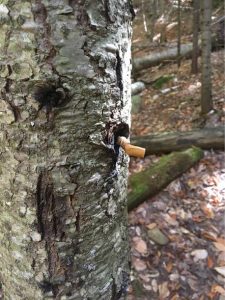In the past three to four years there has been a surge in the number of hikers in the Adirondacks. With this increase comes the littering of powerade bottles and energy bar wrappers, and according to Forrester Tate Connor, “an increase in human waste at an alarming rate.” Uneducated hikers defecate near water sources, leave their bodily waste unburied, and/or blatantly drop their human waste on the side of (or, in some cases on…) the trail. “We’re starting to see thresholds,” said Connor. The increased traffic intensifies the erosion problems on trails “that are laid out incorrectly.” In addition to the trails themselves, DEC official David Winchell discussed how the septic system at Adirondack Loj failed on Labor Day due to overuse. However, the problem lies not just in the numbers. The use of social media has crafted a new type of hiker – one that is often underprepared and uneducated.
While this influx of hikers feels like a modern issue, director of Adirondack Trail Improvement Society (ATIS) Tony Goodwin notes that we are situated in one of “three distinct surges in hiker use – each one of which caused concerns about potential overuse.” According to Goodwin, the first surge occurred in the early 70s – spurred by “glossy magazines devoted to backpacking” and better equipment. It wasn’t until 1974 when gas prices tripled, that eventually the number of visitors puttered out and didn’t increase for 15 years. The second surge occurred in the 90s due to a cultural focus on “fitness, money, and leisure.” Charter busses ran, hauling swarms of 45 to 50 people to the Adirondack trails. To address this, group limits of 15 were set – a limit dubbed, the “van standard” (named so, because a typical van at the time could seat around 15). Unit Management Plan (UMP) implementation reduced use for a couple of years. The third surge is the one we are familiar with today. The cause is something Tate Connor, Tony Goodwin, and David Winchell all independently agree on – social media and technology. In an era where a photo can be taken and shared with hundreds of people in a matter of moments, individuals can view their friends’ adventures and decide, as Connor put it: “that’s a cool picture on Cascade. Let’s go!”
“Until we get the numbers, we can’t say this summer broke records,” said Connor. “We had amazing weather throughout the summer, and that combined with social media led to a perfect storm for overuse.” Tony Goodwin echoed Connor, stating that “the Internet and cell phones have put a whole new face on hiking.” When others see “pretty pictures people post of where they’ve gone,” they feel compelled to explore the same places.
Not only has social media sparked the increase in hikers, but, as Goodwin pointed out, with new technology, hikers feel they have to prepare less. For example, technologically dependent hikers will arrive at a hike without looking over a map. They instead take a picture of the map at the trailhead on their phones, which, as Goodwin said, may die mid-hike. Connor laments that many unprepared individuals could be avoided if they received their hiking information from reputable organizations like the Boy Scouts, not the internet.
The lack of education reveals itself through statistics on search and rescues. “Last year we hit 100 search and rescues in the High Peaks region,” said Winchell. “From 2011 to 2015, there was a 60% increase in search and rescue from the previous five years.” As a result, forest rangers spend more time on search and rescue than education, creating a terrible feedback loop.
Although the surge in hikers may create environmental pressures, it is an economic relief. “The primary reason people come to the Adirondacks is outdoor recreation, and the primary form of recreation is hiking,” said Winchell. “Local businesses like the hiker traffic,” said Goodwin. Because of this, I believe we must learn to work with visitor increase rather than attempt to stifle it. We must look to build more durable trails, create more education outreach, and perhaps use creative parking sticker systems as Goodwin suggests. In listening to Tony Goodwin talk about ATIS and the building of sustainable and resilient trails, I couldn’t help but think what he said could be extended to building a sustainable and resilient park: “It goes slowly….it takes time, but if done right, it lasts a long time.”
